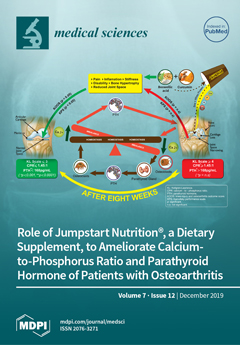The aim of this study was to use Jumpstart Nutrition
® bone supplementing combination with vitamin-K
2 and coenzyme-Q
10 characterized by an innovative delivery system that improves bioavailability of calcium-to-phosphorus ratio (CPR) and parathyroid hormone (PTH) in the management of osteoarthritis (OA).
[...] Read more.
The aim of this study was to use Jumpstart Nutrition
® bone supplementing combination with vitamin-K
2 and coenzyme-Q
10 characterized by an innovative delivery system that improves bioavailability of calcium-to-phosphorus ratio (CPR) and parathyroid hormone (PTH) in the management of osteoarthritis (OA). This eight-week registry included 108 patients treated for symptomatic OA confirmed with radiological images. On top of that, 63 patients used Jumpstart Nutrition
® supplement, mainly prepared with calcium, phosphorus, coenzyme-Q
10, vitamin-K
2, vitamin-D
2, vitamin-C, folic acid, curcumin and boswellic acids. Rescue medication was also recommended. Patients’ pain and functional capacity through outcome measures—knee-injury osteoarthritis outcome scale (KOOS) and Karnofsky performance scale (KPS), biomarkers such as levels of CPR, PTH and 25-hydroxy-vitamin-D were evaluated for the groups with and without supplement using appropriate kits. After eight weeks, the levels of CPR and PTH were all significantly improved (
p < 0.001), fewer subjects had to use rescue medication (
p < 0.05) and variation of pain and functional capacity under KOOS and KPS (
p < 0.05) of the patients in the supplement group compared to controls. This registry study indicates that Jumpstart Nutrition
® can be used safely for effective management of OA patients for the amelioration of CPR, PTH and functional activities confirmed with biomarkers and radiological images correlated with the Kellgren-Lawrance scale.
Full article




